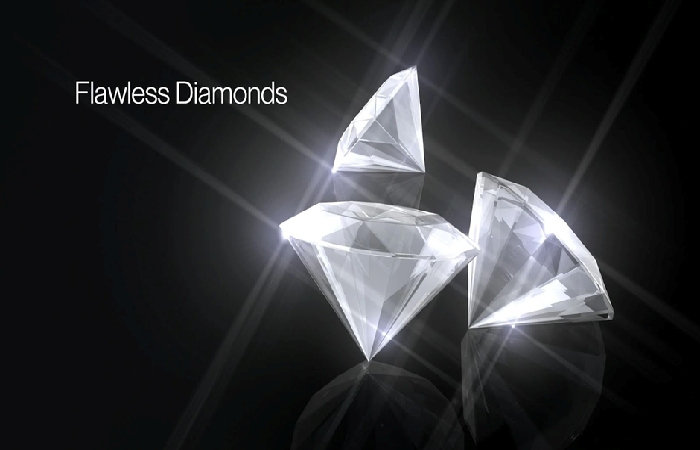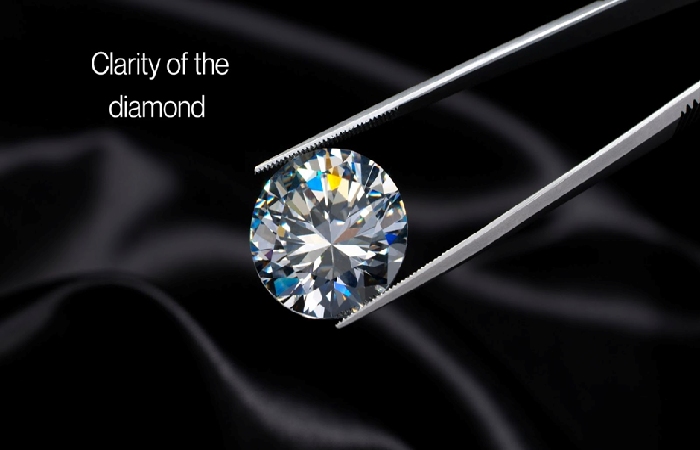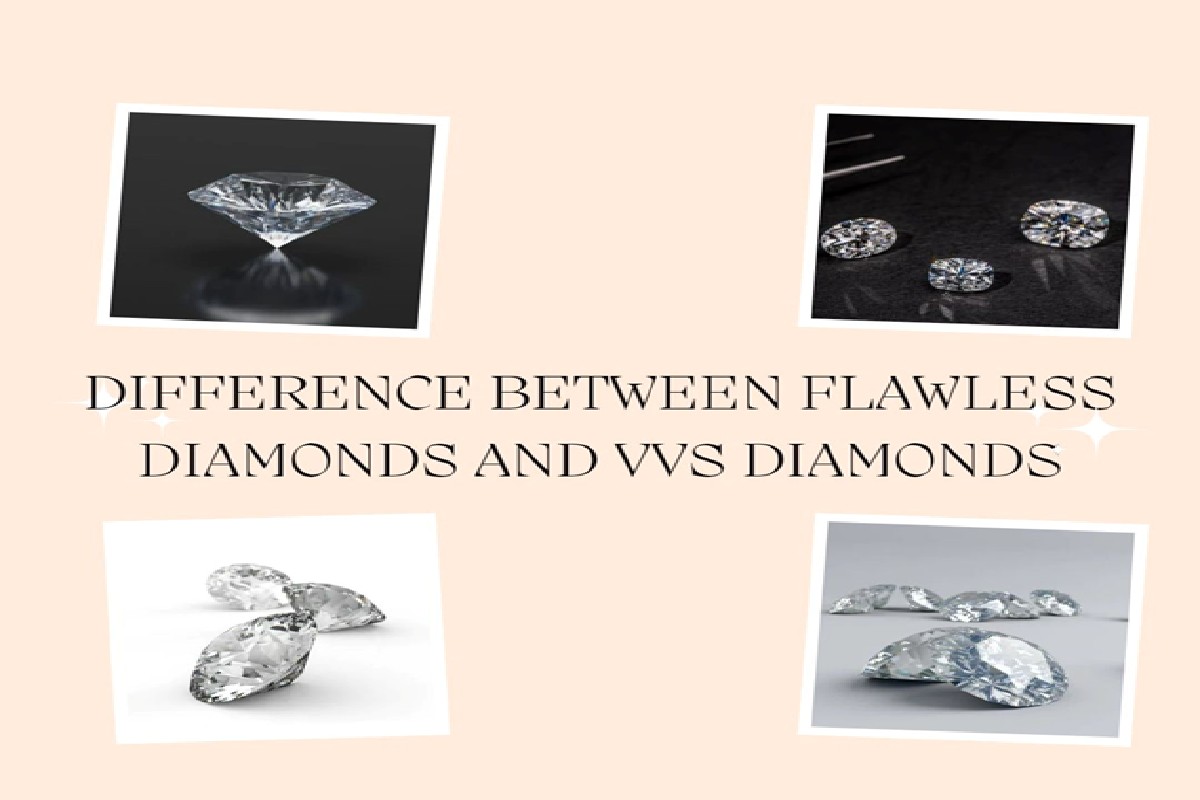Flawless Diamonds and VVS Diamonds – It doesn’t matter if you’re new to the world of diamonds or if you’ve been here for a while. Every diamond enthusiast is sure to find something new to discover every few years. The diamond jewelry industry is pretty versatile in that sense. Think about it: a few decades ago, would anyone have imagined lab-grown diamonds would exist?
These days, we have different diamond clarities for all those interested. People often don’t know the difference between flawless and VVS diamonds. Let’s discuss the same in the next section.
What are VVS Diamonds All About?
Let’s first discuss what VVS diamonds are all about in this section. We’ll also take a deep dive into the link between VVS grading and diamond clarity. VVS diamonds are those diamonds that have “Very Very Slight Inclusions.” What exactly are “inclusions,” you ask? For the uninitiated, inclusions can sound very much like blemishes or flaws.
But you should know that these are far from the same. Think back to your middle school days when you learned the diamond formation process. You may remember that diamonds are formed when you subject carbon to high pressure and heat. Manufacturers these days recreate these conditions for lab-grown diamonds as well.
Well, the point is, mined diamonds come from nature, and the natural process can take a toll on the diamonds. When the carbon that forms diamonds cools, impurities like dirt can make their way into it. As the carbon cools, these impurities become a part of the diamond and are often visible.
These impurities are also called inclusions in the world of diamonds. VVS diamonds have very small inclusions that are invisible to the naked eye. Even a seasoned expert may not be able to tell that a VVS diamond has inclusions. You would need to place a VVS diamond under a 10X magnifying glass to observe these inclusions.
You may not encounter people who carry magnifying glasses, so VVS diamonds would be ideal. But if you’re particular about the clarity of your diamond, then VVS diamonds may not seem like the best choice. That is if you are unaware that there are different types of VVS diamonds available.
Let’s explore the popular types of VVS diamonds in the market before we move further.
VVS1 Diamonds
VVS1s are the clearest of all VVS diamonds, which is why they get the top ranking. The inclusions on VVS1 diamonds are found on the pavilion of the stone. So, these inclusions aren’t very easy to identify, even under a magnifying glass.
These diamonds are among the closest things you can have to flawless diamonds. While they do have inclusions, it makes little sense to forge them because of these. After all, you’re not very likely to find a diamond with no inclusions in most kinds of diamond jewelry.
The inclusions you’re most likely to find in VVS1 diamonds are internal graining and clouds. Again, these are so small that it’s difficult to identify them under magnification. You may even find feather inclusions in some kinds of VVS1 diamonds.
You could ask a gemstone expert to help you determine the kind of inclusion in your VVS diamond. They can also determine the exact size of the inclusions present in your diamond.
VVS2 Diamonds
VVS2 diamonds rank one step below VVS2 diamonds. They’ve earned this position as they have more inclusions than VVS1 diamonds. But, again, the inclusions in these diamonds are not nearly large enough to be observed by the naked eye.
Even an expert eye wouldn’t be able to find the inclusions in VVS2 diamonds. But, under 10X magnification, it’s easy for experts to identify inclusions in the diamonds. This fact would be reflected in the slightly lower price of VVS2 diamonds as well.
But you mustn’t confuse inclusions with blemishes here. Blemishes are different from inclusions in that they’re on the outside. In an earlier section, we discussed how inclusions become a part of VVS diamonds. The process of causing blemishes on diamonds is quite different.
To get diamonds into attractive shapes, manufacturers often cut them with gemstone-cutting machines. As is the case with all machines, these machines can make mistakes. So, the diamonds they churn out aren’t always 100% perfect and have blemishes. Like inclusions, these blemishes are not easily visible to the naked eye.
This is especially true if the blemished diamond forms a part of a necklace or bracelet. While blemishes may be avoidable, inclusions are not. So, you would need to ask a gemstone expert if the diamond you’re looking at has blemishes or inclusions.
You can choose your diamond accordingly or take a look at flawless diamonds instead.
What Are Flawless Diamonds?

You may have come across the term “flawless diamonds” if you’ve ever seen “FL” on a jewelry website. If you see FL written in a diamond description, it means the diamond has no visible inclusions at all. A flawless diamond doesn’t have any blemishes either. So these diamonds are pretty much perfect in the traditional sense.
You won’t be able to pick out inclusions in flawless diamonds even under 10X magnification. This is what makes these diamonds desirable to those who want perfection in jewelry. But you should know that VVS1 diamonds come pretty close to flawless diamonds in this regard.
For those who are particular about diamond clarity, FL is the highest clarity grade there is. Internally flawless diamonds come right after flawless diamonds, followed by VVS1 diamonds. But just because it has the highest clarity grade doesn’t mean flawless diamonds don’t have flaws.
Sure, it sounds contradictory, but every diamond is bound to have flaws. Some lab-grown diamonds are less likely to have flaws than mined diamonds. But then again, even lab-grown diamonds can have blemishes if they do not have too many inclusions.
The heat and pressure under which diamonds are made lead to their developing flaws. The only difference is that some diamonds have bigger flaws than others. Since they have little to no inclusions, flawless diamonds reflect light the best.
That still doesn’t mean it would be a clear-cut choice to opt for these diamonds over VVS diamonds. Let’s explore some of the many differences between flawed and VVS diamonds.
Clarity

Since you have an idea of what these diamonds are, you know FL diamonds are clearer than VVS diamonds. You know that VVS and FL are terms used to describe a diamond’s clarity. The clarity of these diamonds is determined by three factors.
The first factor we’ll talk about here is the number of inclusions. Generally speaking, if a diamond has many inclusions, it’s not considered to be very clear. It often doesn’t matter, even if these inclusions are pretty small. No matter how small they are, if there are too many, the diamond isn’t flawless.
You can tell if these imperfections are present under higher magnification. Even if 10x magnification doesn’t do the trick, 30x or 40x might. So, if you want flawless diamonds, you’d need to opt for one with fewer inclusions. In such a scenario, it’s easy to see why VVS diamonds wouldn’t be your first choice.
But, considering VVS1 diamonds have very few inclusions, you could opt for them. The next factor is the size of the inclusions in the diamond. Large inclusions are more likely to have an impact on the clarity of the diamond. It doesn’t matter if the diamond is flawless or VVS-grade; large inclusions matter.
But if there are just one or two large inclusions in a well-cut diamond, it may not make much of a difference. The type of inclusions found within a diamond also influences its clarity. Some types of inclusions are better avoided than others.
It would be best for you to avoid diamonds that have dark crystal and long feather inclusions. This is regardless of the diamond clarity grade you opt for. Dark crystal inclusions occur where the carbon hasn’t crystallized.
Long feather inclusions make the diamond appear hazy and affect its clarity.
Cost
Another important consideration is the cost of flawless vs. VVS diamonds. As you can imagine, the clearer the diamond is, the more it’ll cost you. A flawless diamond is more likely to burn a hole in your pocket than a VVS diamond. These diamonds are costlier because they offer you greater clarity.
Even those who are unfamiliar with diamonds understand the importance of clarity. So, it’s hardly surprising that diamond clarity would be linked to its price. But, you should also note that the cost of flawless diamonds depends on other factors as well.
The cut and size of the diamond would also matter here. A small, basic-cut flawless diamond won’t cost you more than a large VVS diamond in an elaborate cut. Large VVS diamonds in the round brilliant or princess cut can cost you a fortune. This is true even if the VVS diamond you choose has some inclusions.
But you could save some money on these diamonds if you opt for lab-grown diamonds. These diamonds are created in labs that recreate the natural diamond formation process. So, the diamonds that come out of these labs are the same as a mined diamond in most aspects.
The only aspect in which they differ is the pricing. A well-cut, VVS-quality lab diamond may be expensive but not unattainable. It may well cost you less than a flawless diamond that’s not as impressive. The best way to compare prices is to keep the same parameters for both types of diamonds.
Examine the price of FL and VVS diamonds that are of the same size, shape, and cut. Then, you’ll get an idea of how these diamonds are priced and how you can save money on diamond jewelry.
Novelty
If you’re looking for novelty or rarity, flawless diamonds may be the way to go. These diamonds are harder to find than VVS diamonds. The disadvantage is that you will have few options when selecting jewelry with flawless diamonds. We talked about how it’s pretty much inevitable to find inclusions in your diamonds.
So, it’s not hard to imagine that it would be nearly impossible to find a diamond with no inclusions at all. The clearer you want your diamond to be, the harder it’ll be to find it. So, this greatly limits the options you have if you want to wear jewelry with flawless diamonds.
You’ll find that less than one percent of all diamonds earn a flawless grade. Imagine being able to find a flawless diamond that’s easily affordable in such a scenario. But, you’ll have many more diamond jewelry options if you’re willing to try out VVS diamonds.
This is true even though VVS diamonds aren’t easy to find either. VVS diamonds come in two varieties, as you may have guessed. You’d find considerable imperfections in VVS2 diamonds compared to flawless diamonds. VVS2 diamonds may have graining on the inside or outside.
So, these diamonds are considered more common, and you can access them easily. You can explore a range of VVS diamonds that fit into your budget in the cut and shape you want. Or, you can opt for a brilliantly cut, flawless diamond that’s unlike any other in the market.
If it’s a novelty you’re chasing, make sure you have a diamond that’s framed in well-crafted jewelry. Even the clearest FL diamond will be lost if it is set in a dull piece of jewelry. So, for a unique piece, choose intricate diamond jewelry regardless of the clarity of the diamond.
Conclusion
To conclude, there are considerable differences between flawless and VVS diamonds. But you’ll find that these differences aren’t significant enough to make the choice easy. You may find flawless diamonds appealing because they’re rare and have great quality.
Some people may find VVS diamonds appealing as they have good clarity and are accessible. Besides, VVS diamonds can be more affordable for those opting for lab-grown diamonds. These diamonds are ideal for your special occasions if you choose the right jewelry.
The diamond jewelry you choose should be a reflection of your preferences. Remember, there’s more to a diamond than its clarity grade. So, if you want something 100% unique, a flawless diamond may seem like the obvious choice. But if you’re willing to go the extra mile, a VVS diamond can do the job too.
A little research would go a long way here, so it’s a good thing we’ve done it for you. Now all that’s left for you to do is pick a diamond that’s worthy of you or the one you’re buying it for.


